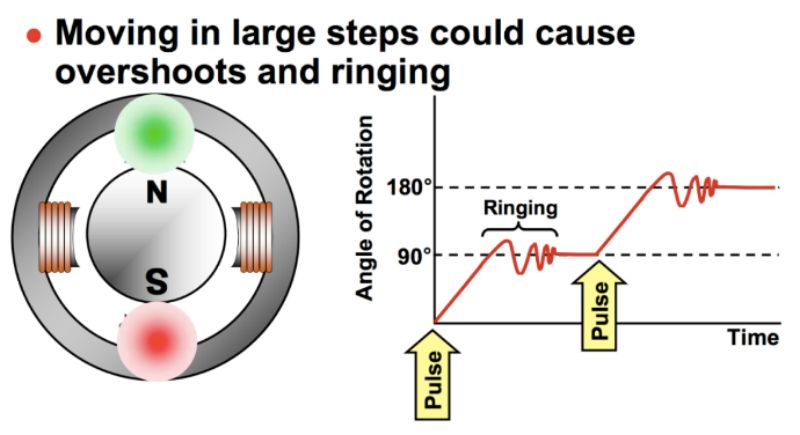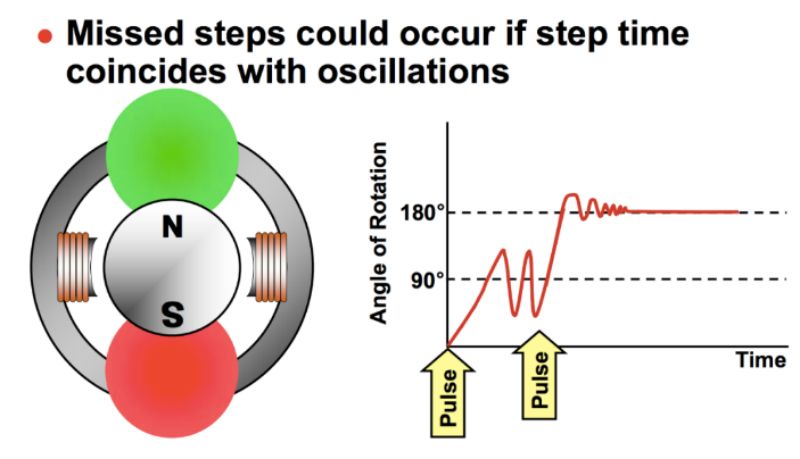Yn normale operaasje, destappenmotorbeweecht ien staphoek, dus ien stap foarút, foar elke ûntfongen kontrôlepuls. As kontrôlepulsen kontinu ynfierd wurde, draait de motor kontinu neffens. Ut stap gean fan 'e stappenmotor omfettet ferlerne stap en oerstap. As de stap ferlern giet, is it oantal stappen dat de rotor foarútgiet minder as it oantal pulsen; as de stap oerstekt wurdt, is it oantal stappen dat de rotor foarútgiet mear as it oantal pulsen. It oantal stappen foar ien ferlerne stap en oerstap is gelyk oan in hiel mearfâld fan it oantal rinnende slagen. In serieus stapferlies sil derfoar soargje dat de rotor yn ien posysje bliuwt of om ien posysje trilt, en in serieuze stapoerstap sil derfoar soargje dat de motor oersjit.
Ferlies fan stap oarsaak en strategy
(1) De fersnelling fan 'e rotor is stadiger as it rotearjende magnetyske fjild fan 'estappenmotor
Ferklearring:
As de fersnelling fan 'e rotor stadiger is as it rotearjende magnetyske fjild fan 'e stappenmotor, d.w.s. leger as de fazeferoaringssnelheid, genereart de stappenmotor útstap. Dit komt troch ûnfoldwaande krêftynfier nei de motor en it syngronisearjende koppel dat yn 'e stappenmotor generearre wurdt, lit de rotorsnelheid net de rotaasjesnelheid fan it statormagnetyske fjild folgje, wêrtroch't útstap ûntstiet. Om't it dynamyske útfierkoppel fan in stappenmotor ôfnimt as de frekwinsje fan trochgeande operaasje tanimt, sil elke wurkfrekwinsje heger as dat in ferlern stap produsearje. Dit ferlies fan stap jout oan dat de stappenmotor net genôch koppel en net genôch sleepkapasiteit hat.
Oplossing:
a. Fergrutsje it elektromagnetyske koppel dat troch de stappenmotor sels generearre wurdt. Dit kin yn it nominale stroomberik wêze om de rydstroom te ferheegjen; yn it hege frekwinsjeberik is it koppel net genôch, jo kinne de rydspanning fan it rydsirkwy ferbetterje; feroarje nei in stappenmotor mei in grut koppel, ensfh. b, sadat de stappenmotor it koppel ferminderet om te oerwinnen. Dit kin dien wurde troch de wurkfrekwinsje fan 'e motor op passende wize te ferminderjen om it útfierkoppel fan' e motor te ferheegjen; in langere fersnellingstiid yn te stellen, sadat de rotor genôch enerzjy krijt.
(2) De gemiddelde snelheid fan 'e rotor is heger as de gemiddelde rotaasjesnelheid fan it statormagnetyske fjild
Ferklearring:
De gemiddelde snelheid fan 'e rotor is heger as de gemiddelde rotaasjesnelheid fan it magnetyske fjild fan 'e stator. As de stator langer oanstutsen en oanstutsen wurdt as de tiid dy't nedich is foar de rotor om fierder te stappen, dan krijt de rotor tefolle enerzjy tidens it stapproses, wêrtroch't it útfierkoppel dat troch de stappenmotor produsearre wurdt tanimt, wêrtroch't de motor te fier giet. As de stappenmotor brûkt wurdt om dy meganismen oan te driuwen dy't de lading omheech en omleech bewege litte, is de kâns grutter dat it ferskynsel fan te fier gean ûntstiet, wat komt troch it feit dat it koppel dat troch de motor nedich is ôfnimt as de lading nei ûnderen beweecht.
Oplossing:
Ferminderje de oandriuwstroom fan 'e stappenmotor om it útfierkoppel fan' e stappenmotor te ferminderjen.
(3) Traachheid fan 'estappenmotoren de lading dy't it draacht
Ferklearring:
Troch de traachheid fan 'e stappenmotor sels en de lading dy't er draacht, kin de motor net fuortendaliks starte en stoppe wurde tidens operaasje, mar ûntstiet der in ferlern stap by it starten en in oerstap by it stopjen.
Oplossing:
Troch in fersnellings- en fertragingsproses, d.w.s. begjinnend mei in legere snelheid, dan stadichoan fersnelle nei in bepaalde snelheidsoperaasje, en dan stadichoan fertrage oant it stopjen. Redelike en soepele fersnellings- en fertragingskontrôle is de kaai om de betroubere, effisjinte en krekte wurking fan it stepper-oandriuwingssysteem te garandearjen.
(4) Resonânsje fan stappenmotor
Ferklearring:
Resonânsje is ek in oarsaak fan út-stap. As de stappenmotor kontinu yn wurking is, en de frekwinsje fan 'e kontrôlepuls gelyk is oan de yntrinsike frekwinsje fan 'e stappenmotor, sil resonânsje foarkomme. Binnen ien kontrôlepulsperioade wurdt de trilling net genôch ferswakke, en komt de folgjende puls, wêrtroch't de dynamyske flater tichtby de resonânsjefrekwinsje it grutst is en sil feroarsaakje dat de stappenmotor stap ferliest.
Oplossing:
Ferminderje de oandriuwstroom fan 'e stappenmotor op passende wize; brûk de ûnderferdielingsoandriuwmetoade; brûk dempingsmetoaden, ynklusyf de meganyske dempingsmetoade. Al dizze metoaden kinne motoroszillaasje effektyf eliminearje en it ferskynsel fan útstap foarkomme.
(5) Ferlies fan pols by it feroarjen fan rjochting
Ferklearring:
It wurdt oantoand dat it yn elke rjochting akkuraat is, mar it sammelet ôfwiking op sa gau as de rjochting feroare wurdt, en hoe faker it feroare wurdt, hoe mear it ôfwykt.
Oplossing:
Algemiene stappenmotor oandriuwing op 'e rjochting en puls sinjalen hawwe bepaalde easken, lykas: de rjochting fan it sinjaal yn 'e earste puls lâns de opkommende râne of fallende râne (ferskillende oandriuwingseasken binne net itselde) foar de oankomst fan in pear mikrosekonden om te bepalen, oars sil d'r in puls fan 'e wurkingshoeke wêze en de werklike needsaak om yn' e tsjinoerstelde rjochting te draaien, en úteinlik it falen ferskynt him yn hoe mear jo geane, hoe mear bias, hoe lytser de trochbraak is, de oplossing wurdt benammen brûkt yn 'e software om de logika fan it ferstjoeren fan in puls te feroarjen. De oplossing is benammen om software te brûken om de logika fan it ferstjoeren fan pulsen te feroarjen of in fertraging ta te foegjen.
(6) Softwarefouten
Ferklearring:
Kontrôleprosedueres dy't liede ta ferlerne stap is net ûngewoan, de needsaak om it kontrôleprogramma te kontrolearjen is gjin probleem.
Oplossing:
As de oarsaak fan it probleem in skoftke net fûn wurde kin, binne der ek yngenieurs dy't de stappenmotor in skoftke rinne litte om de oarspronklike homing opnij te finen.
Pleatsingstiid: 19 maart 2024


